Abstract
This paper aims to underline the importance of the packaging redesign process and the potential benefits that can be derived from this for both the environment and the community. The research demonstrates that the redesign of paper corrugated packaging has cost savings for most links of the supply chain such as the industrial customers, retailers, wholesalers and final consumers. In addition, an applied case study will be used that aims to provide evidence that the redesign process could further offer weight and transportation benefits, provide better environmental performance and finally offer better protection for the packaged products. The alternative packaging suggestions made in the research refer to the secondary paper corrugated packaging since the objective is to show the value of the redesign process. The research provides the tools for a packaging designer, on how to estimate, analyse, redesign and compare different approaches, finding the way to a more sustainable packaging supply chain.
1. Introduction
Companies are constantly seeking ways to improve their performance in all of their operations. During the last two decades a significant issue appears to be the analysis of the packaging performance in a company’s supply chain and the possible ameliorations that may affect in financial and logistical improvements. An alternative suggestion to improve the performance of a company’s current packaging supply chain would be to redesign completely or partially the existing packaging practices applied to the protection of a product.
Many researchers agree that packaging sustainability is currently going through a redesigning process. Magnier, Schoormans, and Mugge (Citation2016) define packaging sustainability as the effort to reduce the product footprint through altering the product’s packaging. For instance, as Eubanks (Citation2009) affirms, it is common ground for packaging engineers to seek innovative ways of enhancing the existing packaging characteristics of a product, in order to achieve further cost reduction, as well as a performance improvement.
According to Johnson (Citation2009), many companies, including Natural Resources Inc. and Starbucks Coffee Company, are striving to reduce packaging expenditure, while improving the packaging design of their products along with enhancing their environmental performance. According to Molina-Besch and Pålsson (Citation2014) a way for a company to reduce the environmental impact of its logistical operations is to involve logistics managers in product and packaging development. In this way, the environmental performance of the product and its packaging will be critically examined. They also argue that logistics managers should discuss the packaging issue not only with marketing department, but with environmental department as well in order to achieve the perfect balance between the appearance of the packaging and its environmental performance. In the same manner, García-Arca, Carlos Prado-Prado, and Trinidad Gonzalez-PortelaGarrido (Citation2014) describe that various packaging decisions should not be one-sided but instead to be based on multiple sources in order to combine different data, needs and options. According to Klevås (Citation2005) there is a tight connection between the product, various logistics activities and the packaging itself. Klevås argues that since product and its packaging is strongly connected and affected by each other, they strongly affect the efficiency of logistics activities and any change happening to any of them may result to significant sub-optimisation of the whole process.
Companies are taking steps towards improved sustainability and efforts are observed in transportation and the use of packaging. Kroger CEO (Orgel Citation2011) describes that effective sustainability needs strong efforts and collaboration with the suppliers in fields such as an effective transportation of the products to the market with minimum environmental cost (less truck miles) and the use of less packaging or packaging materials. As described in ‘Packaging power’ (Citation2010), packaging designers are forced to combine many factors such as cultural opinions, lifestyle choices, green business practices, unit costs and durability of packaging materials in order to establish competitive advantages of the products. It is also described that it is necessary for each department to be involved in this process in order to find a solution that meets all needs and expectations. Svanes et al. (Citation2010) have even developed a methodology combining a number of factors (i.e. environmental sustainability, distribution costs, product protection, market acceptance and user friendliness) in order to be used, among others, in packaging design and optimisation processes. They argue that the current methodology could be used as a toolbox in packaging design process.
This research analyses the packaging redesign issue to bring to light the advantages of the specific process for a company’s supply chain. The investigation will provide a detailed analysis of how simple changes to the shape or dimension of the secondary paper corrugated packaging could offer important advantages to the users throughout the supply chain. These advantages include a better utilisation of vehicle space during transportation and cost reductions that could be achieved by an increase of the volume of products carried per vehicle in combination with a lower total packaging cost.
2. Literature review
2.1. Packaging sustainability
Although sustainability is a relatively old concept and its existence follows a parallel path of human history, it is not easy to distinguish between its special characteristics and the way it is perceived and acknowledged by different cultures or even social structures throughout different eras (Redclift Citation1999). Moreover, sustainability has come to be used in environmentalism although, as cited by Holling (Citation2000), as a philosophy, it embraces economic, political, cultural and sociological features.
Regarding the packaging, environmental sustainability plays an important role mainly because the packaging is versatile. Nonetheless, it is not unusual for the different segments of the packaging community to have different perceptions of the sustainability notion.
Packaging influences the environment from a logistics point of view in many ways. It does influence the logistics efficiency as it adds weight to products during transportation and handling. Packaging has a direct environmental impact regarding the weight/volume of the packaging itself, as well as an indirect environmental impact reflected on the property of packaging of the packed products. This is linked to the products loss along the supply chain, the transportation efficiency and the ease of handling (Molina-Besch and Pålsson Citation2014).
As cited by Jedlička (Citation2009), according to the classical notion, the main target of packaging is to protect the product. However, one should bear in mind that eco-packaging should have different attributes, rendering it not only proper but also sustaining its environmentally – friendly aspect, while at the same time serving its fundamental purpose. However, despite the fact that both governments and consumers keep asking for more ‘green’ packaging, what an industrial customer needs is enticing packaging for the products.
In addition, consumers require that the product should be properly packaged and marketing departments request that packaging should be luxurious and attractive enough to promote the product. The dilemma is obvious to companies as they are under pressure to combine the multitude of conflicting demands. This entails that a packaging solution is, one that is ‘green’, attractive, provides the required protection to the product and strengthen the brand image (Sustainable Packaging Citation2004). Dominic et al. (Citation2015) conducted a relevant research where they describe that packaging designers are focused more and more on balancing packaging cost, product protection and packaging impact on the environment. According to a survey conducted by Steenis et al. (Citation2017) the notion of sustainability is important for the consumers though not highly important for determining consuming habits. Their study also reveals that sustainable packaging should further enhance the consumer’s perceptions concerning the quality of the product in order to be well accepted.
From a marketing perspective, according to Lo, Tung, and Huang (Citation2017), it is vital for the products to be properly packaged since packaging is a decisive factor for the consumers affecting their buying decisions. They also describe that the consumers tend to believe that a poor quality packaging is often used to contain products of low or poor quality and so they usually avoid buying such products.
Koeijer, Wever, and Henseler (Citation2017) highlights three primary functions of packaging such as protection, utility and communication. They highlight that the structural packaging design is linked with the protection and utility functions, where the graphical packaging design is concerned with the communication. The protection function is seen here as protecting the contained products from the environment where the utility is seen as the function that enables products distribution and use.
As described by Henry Renella (Senior vice president of the New York-based Estee Lauder’s Global Packaging development) (Luxury consumers prefer subtle sustainability messages on packaging Citation2011) although a luxury brand should undoubtedly be aligned and use sustainable packaging, the image and impression of the product’s luxury packaging should stay intact. For example, converting packaged food products into sustainable alternatives by using other types of packaging with more sustainable characteristics, could change the way that consumers perceive the quality of the product itself (Magnier, Schoormans, and Mugge Citation2016).
Another important aspect that should be taken into account is the one described by Williams and Wikström (Citation2011). They argue that although in the past the idea was to use less (packaging) and recycle more, the new environmental trends suggest, that the environmental protection that packaging itself offers, should be the focus. They also recommend that the industry should reconsider its practices and if necessary to be ready to increase the environmental impact from the new packaging, should this lead to the reduction of food losses. Given the increasing demand for more products, the idea is to estimate and compare the environmental consequences between more and of better quality packaging and food losses before making the right decisions. As described by Pullman and Wikoff (Citation2017) the land filled food waste causes serious environmental implications e.g. increased carbon impact. For this reason, it would be more advantageous for the environment to redesign and make appropriate package changes in order for the industry to achieve food waste reductions. In addition, according to a research conducted by Peano, Vincenzo Girgenti, and Giuggioli(Citation2017) in many cases, the substitution of food packaging with other, more suitable packaging materials may result to a food waste reduction due to the extension of the conservation period of the product itself.
García-Arca, Carlos Prado-Prado, and Trinidad Gonzalez-PortelaGarrido (Citation2014) state that many companies perceive any introduced change as a threat to their normal activities. However, nowadays improvements in both the efficiency and sustainability of their logistics processes are inevitable, due to high competitiveness.
Traditional practices are about to change. As cited by Hildebrandt (Citation2012), some bottling companies have started packing wine in aluminium cans in order to assist portability. In addition, the use of aseptic packaging in beverage applications has increased since this type of packaging allows the perishable and sensitive beverages (e.g. coconut water, exotic tropical fruit juices) to be transported by common transportation methods and be stored at ambient temperatures. Moreover, according to the same study, nearly 2/3 of the aluminium cans in circulation are recycled while this material appears to be lighter (less weight per shipment results in less fuel use which then results in less CO2 emissions that reduces cost). At the same time the production of recycled aluminium cans requires 95% less energy compared to those produced using virgin materials.
On the other hand, what consumers expect should seriously be taken into account. Lucas (Citation2016) explains that consumers keep asking for more ‘green’ products, yet they also expect that the cost should be absorbed by industry. In addition, Goodrich (Citation2012) supports the view that environmental sustainability is a priority for consumers, which strongly affects their consuming habits. However, he also adds that the citizen’s active participation in various environmental activities is of the utmost importance at this point, since it ensures that well-informed citizens will seek and find ways to support sustainability.
It should be stressed that the industry is currently making real progress in the packaging field. In 2013 NewPage Corp. earned the Sustainability Award in the Ameristar 2013 competition for its LittleFoot 100% Compostable Packaging Barrier Product (Knights Citation2014). The above package, is produced from renewable resources while it is fully compostable and manufactured by combining paper and metalised cellophane, which makes it possible to avoid the use of foil or other polymers. Its composition ensures high protection from oxygen and moisture for the product, while offering a notable printing surface and distinct appearance.
Further announcements made by big companies clearly show the way towards packaging sustainability. A remarkable example is that of Sainsbury, which announced that the company plans to increase the use of recycled and recyclable packaging materials and at the same time make it easier for its UK customers to recycle. The company also announced that one of its main aims is to reduce the use of packaging by half for its store brand products (J Sainsbury plans to reduce store brand packaging Citation2011). Back in 2012, Kering, the French giant group operating in apparel and accessories with brands such as Alexander McQueen, Dodo, Saint Laurent, Puma and many others, announced its sustainability targets, including the reduction of carbon emissions, the elimination of PVC from all collections, the use of packaging that is 100 per cent sustainable and so on (Socha Citation2014).
Similarly, other big retailers, such as Walmart, have engaged in packaging sustainability. As a key objective, for example the shoe boxes used throughout shops in the US have been redesigned. According to Kalkowski (Citation2012) the new design economised on paper by 692 tons approximately, within the first 10 months in 2011. Furthermore, the company decided to ask its toy suppliers to replace the wire ties used to prevent the toy from moving in the box with ties made by natural fibres. In this way, in 2 years’ time approximately, the Walmart products managed to save up to 1.6 billion feet of wire.
A detailed packaging redesign can result in reduction of the space which a product occupies during transportation or warehousing (Calver Citation2004). In addition, according to Bix et al. (Citation2009), intermediaries such as fillers or transporters require that packaging should be easy to process, handle, store, ship and track in order to maximise product efficiency without increasing associated expenditure.
As discussed in Plastics News (Citation2012), the US consumer products company Procter & Gamble Co. decided to redesign its packaging for some of its products by reducing the use of plastic materials and substituting them with mouldable pulp. This act resulted in the reduction of not only the gross weight of the products but at the same time the reduction in the use of the overall plastic materials per product.
It should not be overlooked that the above packaging innovations would not have materialised if accomplishment in two other fields had not preceded: packaging machinery and packaging materials. As commented by Brulz (Citation2013) the invention of biopolymers was not adequate since the industry would have to make the proper changes or additions to machinery so as to ensure that the materials would be fully operational, would not hinder the manufacturing process itself or generate printing failures.
Lastly, it should also be considered that more often than not packaging cannot be substituted and that in many cases, companies cannot use lighter, bio-degradable packaging or that made from recycled materials (Georgakoudis Citation2014). It may be easy to find new innovative and sustainable ways to pack shoes, for example, or use new wrapping materials and lighter corrugated boxes to protect electronic equipment and detergents, for instance, but is not always easy to substitute primary packaging for food (e.g. biscuits, rice, flour and so on) (Kalkowski Citation2012). The above can be further advocated if legislation such as that of the Food Standards Agency (Citation2013) in the UK is taken into consideration:
…it is necessary for all materials being used to have been manufactured in such a way that they comply with the Framework Regulation (EC) No 1935/2004 for materials and articles in contact with food, that is, that they should not transfer their constituents to food in quantities that could endanger health, bring about an unacceptable change in the composition of the food or bring about a deterioration in the organoleptic properties of the food.
2.2. Packaging redesign
An alternative solution that may result in serious improvements to the performance of a company’s packaging supply chain would be to redesign completely or partially the existing packaging practices applied to the protection of a product. The expansion of many companies overseas and to bigger markets (compared with the domestic markets where they used to trade), has increased the distances between the place of production and the point of consumption (Jahre and Hatteland Citation2004). Additionally, according to Hellström and Nilsson (Citation2011) changes in the consumer habits and the simultaneous increased demand for new products force the companies to find and use new and innovative packaging for their goods. This means that companies seek to redesign or totally change their packages in order to make the transportation, the warehousing and the handling of the products easier and at the same time improve their environmental performance.
This study will focus on the redesigning of the secondary packaging, leaving the primary packaging intact since in most cases the primary packaging has involved serious marketing elements (e.g. shape, size etc.) and potential changes could influence the consumption of the product.
The main idea following the redesign of the secondary packaging can be summarised as follows:
To achieve a better utilisation of vehicle space during transportation, which if realised would further decrease various transportation costs, through increasing the volume of the carried products. Calver (Citation2004) supports the suggestion that a detailed packaging redesign can result in a reduction of the space which a product occupies during transportation or warehousing. In addition, according to Bix et al. (Citation2009), intermediaries such as fillers or transporters require that packaging should be easy to process, handle, store, ship and track in order to maximise product efficiency without increasing associated expenditure.
To achieve a better distribution of the total packaging weight per piece. This could be achieved by an increase in the volume of products carried during transportation, caused by redesigning the secondary packaging.
To improve the quality of secondary packaging, in order to decrease damage during transport or handling operations. According to Calver (Citation2004), the redesigning process should be examined in such a way, so as to discern if any adjustments can be made to reduce product wastage owing to improper handling.
3. The case study
The following case study investigates the advantages of redesigning the corrugated (secondary) packaging for two different products. The selection for the investigation of the specific type of packaging (secondary) was based on the following assumptions:
| (1) | The primary packaging involves serious marketing elements (e.g. shape, size, etc.) and potential changes could influence the sales of the product. | ||||
In order to investigate the redesigning process and the advantages that may be derived from conducting it, two products (2TMIX and glass wine bottles of 0.75lit) were selected randomly in order to be analysed. A Paper Packaging Company in Greece has provided all the necessary information concerning these products, including their technical characteristics (size, weight), as well as the packaging type currently used for each of the products, in order to help the researcher proceed with the investigation. Due to confidentiality reasons the name of the company will not be made available. Packaging design software Tops Pro (version 5.03, www.topseng.com), was used for the investigation.
3.1. Case study: description
As shown below, the analysis includes three different variations to the case study. Case A1 is the actual, current packaging situation. The main concept concerns the redesigning of the secondary packaging of the product in order to measure and evaluate the advantages (if any). After redesigning the secondary packaging (concerns a single wall corrugated packaging) two suggested cases were derived. Case A2 and Case A3 have been developed to demonstrate the advancement as an alternative packaging solution. The main idea behind the current analysis is to evaluate the advantages coming from a single redesign of the secondary packaging without changing other main elements such as the pallet type or the kind of vehicle used.
A liquid product used for the lubrication of two-stroke engines named as 2T Mix, is currently packaged into a plastic bottle (primary packaging) with specific dimensions (see Figure ). In all cases analysed here, the primary packaging (bottle), remains the same.
Figure 1. Primary packaging overview. (Source: Georgakoudis Citation2014).
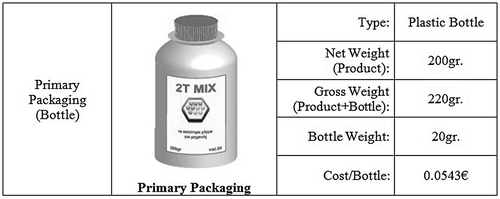
In addition, the type of the corrugated secondary packaging used: Single Wall Corrugated Board, also remains the same. In general the type of the corrugated box (gr/m2, paper type used in inner layers etc.)is determined by special factors such as product kind, weight included, storage time, handling losses, humidity, transportation conditions and stacking method. These conditions are considered to be unchanged in all cases under investigation and for this reason the kind of the corrugated box remains the same in all three cases.
The pallet used in all three cases below is a Europallet (800 × 1200 mm) weighing 25 kg/piece. Furthermore, the pallets are assumed to be returned and for this reason, their cost is not included in the case study. It should be noted that pallet double stacking is not allowed.
The vehicle used has the following dimensions as presented in Table :
Table 1. Vehicle dimensions.
Payload (Maximum Carrying Weight) of the vehicle in all three cases has been determined to be: 25,000 kg.
3.1.1. Restrictions
The following restrictions have been considered for the developed case study.
Shelf Height Restriction defined by the Warehouse is less or equal to 2100 mm. The pallet should not exceed the given maximum height of 2100 mm.
Transportation Height Restriction is less or equal with 2300 mm. The pallet should not exceed the given maximum height of 2300 mm due to given vehicle’s dimensions.
Unit Load includes paper corrugated boxes which are strictly corresponding accordingly to each of the three cases studied. All products carried by the vehicle are the same: 2TMIX packaged as shown in each case.
Pallet Overhang: 0 mm. This means that overhangFootnote 1 is not allowed.
CASE A1 – 2T MIX
The primary packaging is a plastic bottle weighing 20gr (Figure ). Its gross weight (bottle and included product) is 220gr. The cost per bottle is 0.0543€. The bottle contains multiple marketing elements such as a label and specific cap colour in order to inform the user about the contained product.
As in Figure , the secondary packaging (case) is a paper corrugated box, weighing 329gr. The inside dimensions of the shipper are (Length × Width × Depth in mm): 325 × 111 × 610 (see Figure ). The outside dimensions of the shipper are (Length × Width × Depth in mm): 333 × 119 × 625 (technical information provided by the Paper PackagingCompany). While the inside dimensions are critical for the contained product, the outside dimensions affect the way that the boxes are stacked and clearly determine the total occupied area. In this case study (Case A1) each corrugated box contains 50 pieces of primary packaging and the gross weight per shipper (product and total packaging) are 11329gr. The total packaging weight per shipper is 1329gr.
Figure 2. Secondary packaging overview. (Source: Georgakoudis Citation2014).
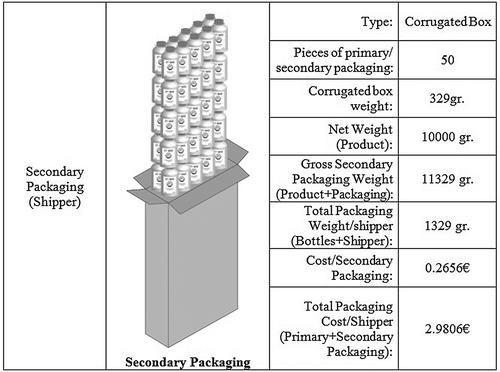
Figure 3. Secondary packaging dimensions overview. (Source: Georgakoudis Citation2014).
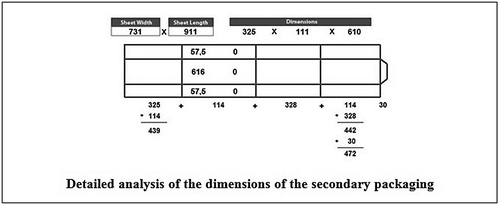
Each shipper costs 0.2656€. The total packaging cost per shipper (primary and secondary packaging) is 2.9806€.
As shown in Figure , the shippers are stacked onto Europallets (dimensions of a Europallet: 800 × 1200 mm). Each pallet contains 69 shippers (thus 3450 bottles). Pallet height is 2022 mm. The gross pallet weight is ~807kgr (pallet weight included). The product weight per pallet is 690kgr while the total packaging cost comes up to 205.66€.
Figure 4. Palletising report. (Source: Georgakoudis Citation2014).

Finally, as shown in Figure the pallets are placed into a semi-trailer (Length × Width × Depth in m: 13.6 × 2.42 × 2.4). Each vehicle contains 30 pallets (thus 2070 shippers and 103,500 bottles) and the gross load weight is 24201kgr (pallet weight included). The total product weight per vehicle load is 20700kgr thus the total packaging weight per vehicle load is 3500kgr. The total packaging cost per vehicle load is 6169.84€.
Figure 5. Vehicle load overview. (Source: Georgakoudis Citation2014).
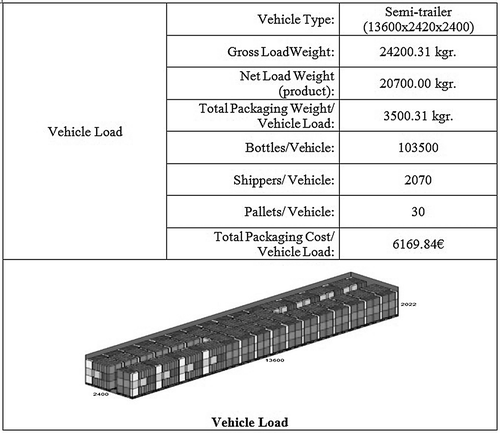
CASE A2 – 2T MIX
The primary packaging is the same as in Case A1 (see Figure ). It is a plastic bottle weighing 20gr and its gross weight (product and bottle included) is 220gr. The cost per bottle is 0.0543€. As already mentioned, the main reason for keeping the primary packaging intact is that the bottle contains multiple marketing elements and furthermore its shape is costly to be changed.
Figure 6. Primary packaging overview. (Source: Georgakoudis Citation2014).
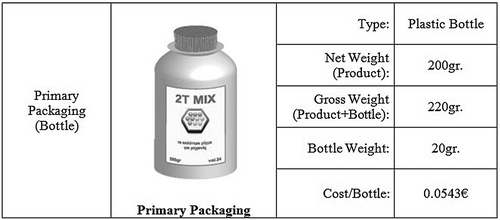
In this case study (Case A2) the secondary packaging was redesigned in order to investigate an alternative to Case A1 solution. While the number of the contained products remains the same as in Case A1 (50 bottles), the shipper design changes, causing changes to pallet and vehicle load, to the total number of bottles carried per vehicle and to the total number of shippers carried per vehicle. All these changes are described below.
Figure illustrates a different pattern of placing the bottles in the secondary packaging comparing to Case A1. As shown in Figure , the secondary packaging (shipper) is a paper corrugated box with inside dimensions (Length × Width × Depth in mm): 366 × 236 × 244, weighing 304gr. The outside dimensions of the shipper are (Length × Width × Depth in mm): 374 × 244 × 260 (technical information provided by the Paper Packaging Company). As described above, the inside dimensions of the packaging are critical for the contained product while the outside dimensions affect the way that the boxes are stacked and clearly determine the total occupied area. Each shipper contains 50 pieces of primary packaging and its gross weight (product and total packaging) is 11304gr. The total packaging weight per shipper is 1304gr.
Figure 7. Secondary packaging overview. (Source: Georgakoudis Citation2014).
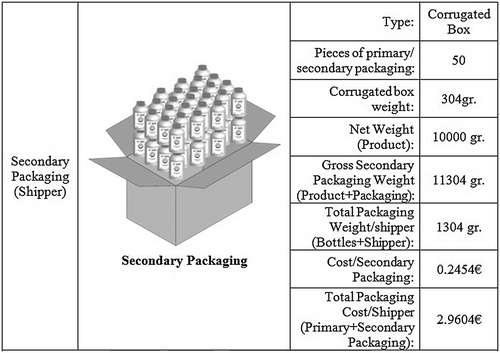
Figure 8. Secondary packaging dimensions overview. (Source: Georgakoudis Citation2014).
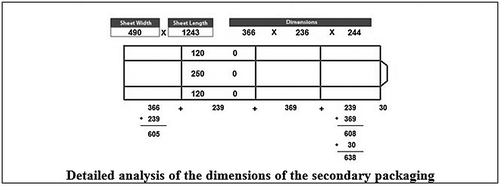
Each shipper costs 0.2454€. The total packaging cost of the shipper (contained bottles and secondary packaging) is 2.9604€.
In Case A2, similar to Case A1, the shippers are stacked onto Europallets with net dimensions 800 × 1200 mm (see Figure ). Each pallet contains 63 shippers and 3150 pieces of primary packaging. Pallet height is 1963 mm. The gross pallet weight is ~737kgr (pallet weight included). The net product weight per pallet is 630kgr and the total packaging cost comes up to 186.51€.
Figure 9. Palletising report. (Source: Georgakoudis Citation2014).

Similar with Case A1, in Case A2 the same type of vehicle has been used, a semi trailer with dimensions (Length × Width × Depth in m): 13.6 × 2.42 × 2.4 (see Figure ). Each vehicle contains 33 pallets (thus 2079 shippers and 103,950 bottles). The gross load weight (with pallet weight included) comes up to 24325.95 kgr, thus the total packaging weight per vehicle load is 3535.95 kgr. The total packaging cost per vehicle load is 6154.67€.
Figure 10. Vehicle load overview. (Source: Georgakoudis Citation2014).
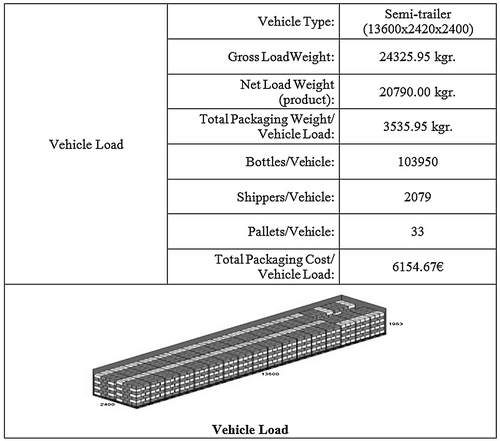
CASE A3 – 2T MIX
The primary packaging remains the same in all three cases. It is a plastic bottle weighing 20gr and its gross weight (product and bottle) is 220gr (see Figure ). The cost per bottle is 0.0543€.
Figure 11. Primary packaging overview. (Source: Georgakoudis Citation2014).
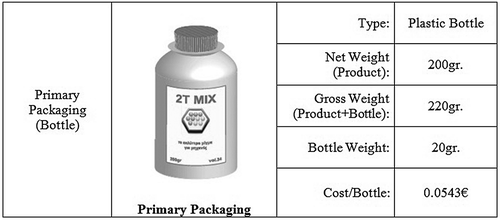
In this case study (Case A3) the secondary packaging was redesigned in order to provide an alternative to the Case A1 packaging solution. The number of the contained products was increased to 54 (comparing with 50 bottles in Case A1). As a result the redesigning process caused changes to pallet and vehicle load as shown below.
Figure illustrates a different pattern of placing the bottles in the secondary packaging comparing to Cases A1 and A2. The type of secondary packaging (shipper) is a paper corrugated box with inside dimensions (Length × Width × Depth in mm): 561 × 162 × 244, weighing 310gr (see Figure ). The outside dimensions of the shipper are (Length × Width × Depth in mm): 569 × 170 × 260 (technical information provided by Paper Packaging Company). Each shipper contains 54 pieces of primary packaging and its gross weight (product and packaging included) is 12190gr. The total packaging weight per shipper is 1390gr.
Figure 12. Secondary packaging overview. (Source: Georgakoudis Citation2014).
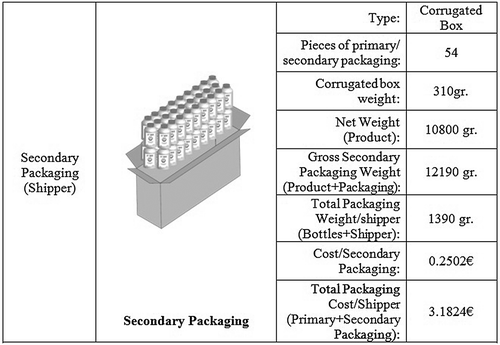
Figure 13. Secondary packaging dimensions overview. (Source: Georgakoudis Citation2014).

Each shipper costs 0.2502€ to buy while the total packaging cost per shipper (primary and secondary packaging) is 3.1824€.
In this case study (Case A3) the shippers, as in all previous cases, are stacked onto Europallets with net dimensions 800 × 1200 mm (see Figure ). Each pallet contains 63 shippers and 3402 bottles of product. Pallet height is 1963 mm. The gross pallet weight is ~793kgr with pallet weight included while the net product weight per pallet is ~680kgr. The total packaging cost per pallet is 200.49€.
Figure 14. Palletising report. (Source: Georgakoudis Citation2014).
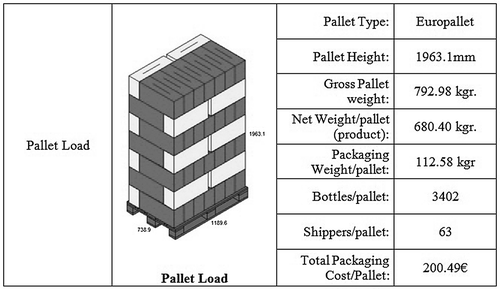
The pallets are placed into a semi trailer with dimensions (Length × Width × Depth in m): 13.6 × 2.42 × 2.4 (see Figure ). Each vehicle contains 31 pallets (thus 1953 shippers and 105462 bottles). The gross load weight is 24582 kgr (pallet weight included) while the total packaging weight per vehicle load comes up to 3490 kgr. The total packaging cost per vehicle load is 6215.19€.
Figure 15. Vehicle load overview. (Source: Georgakoudis Citation2014).
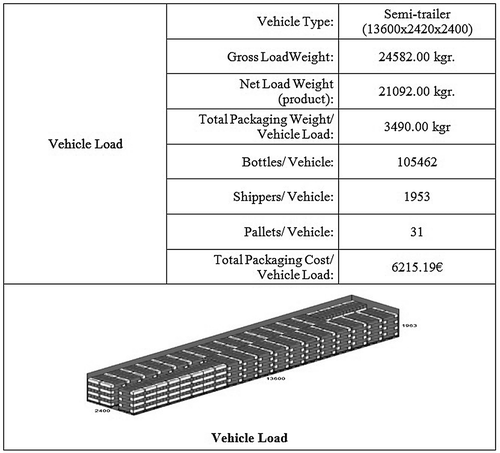
Figure 16. Effects of packaging redesign. (Source: Georgakoudis Citation2014).

4. Discussion – packaging redesign and cost effects
As presented above, from a single redesign of the secondary packaging, a company could achieve an increase in the volume of total bottles carried per vehicle, of 0.43% from Case A1 to Case A2 and 1.9% from Case A1 to Case A3. The difference whilst small is not of minor importance since the industry always tries to optimise supply chains and boost their sustainability.
At the same time, despite the fact that in Case A3, a company could carry nearly 2000 more bottles compared to Case A1, the company would need 117 less shippers/shipment (secondary packaging). In this case study, there is a significant cost saving for the company that comes not only from the fewer shippers per shipment, but also from the larger amount of bottles carried for the same transportation cost.
The net packaging weight/vehicle, will be 1% more from Case A1 to Case A2 and 0.31% less from Case A1 to Case A3.
The total packaging weight associated with a bottle would be 0.56% more, from Case A1 to Case A2 and 2.19% less, from Case A1 to Case A3.
It should be noted that the packaging cost would be 0.25% less from Case A1 to Case A2 and 0.74% more from Case A1 to Case A3.
In general terms, except for the fact that the total cost of packaging would be increased ~45€ per vehicle load from Case A1 to Case A3, all the other elements advocate that the redesign would be advantageous for the company. The increase in the volume of total bottles carried per vehicle clearly boosts the sustainability of the supply chain and this fact, in combination with the decrease in the number of shippers needed to carry this larger amount of bottles, helps the company to save costs and stimulate its competitiveness.
It should be noted that the redesign of the packaging itself is a matter of great importance for a company. Many of them change the type or the shape of the packaging they use for different reasons that range from an aim to show a renewal of the product or to improve the performance of the packaging itself to aims such as to help the environment (or to show a more environmental friendly face to their customers) by using recycled or recyclable materials. For example, in 2013 Pepsi announced a new bottle shape initially available for sale in specific stores. According to Zmuda (Citation2013), Pepsi’s main aim was to provide a new, refreshed image for the brand through its innovative packaging. In addition, as described by Lindell (Citation2013), in 2013 ‘Unreal’, an American candy company decided to make serious changes to its packaging design. Changes were about to be applied not only to the shape, but to the graphics printed on the packaging, as well. According to the company’s co-founder, Melonas: the changes are all just part of the company’s mission to continually evolve.
In any case, the redesign is not as easy as it may sound since it requires the collaboration of individual departments of the company such as the:
| • | logistics – focused to the easiness of use of the new product throughout the supply chain (storage, transportation, handling), | ||||
| • | accounting – interested in the cost for the production of the new packaging, | ||||
| • | marketing – focused on the promotion or the appearance of the new product-packaging, etc. | ||||
| • | Would be advantageous from an environmental perspective, regarding the fuel emissions from one case to another. The advantages could derive from the fact that the redesigning process would make it feasible for more products to be carried per vehicle. Accordingly, this would result in less fuel emissions per product carried. | ||||
| • | Would achieve any further profits for the company. | ||||
5. Conclusions
The concept of redesigning secondary paper packaging has been investigated through the detailed analysis of the case study presented above. The main target for this approach was to achieve a better distribution of the total packaging weight per piece, a better utilisation of vehicle space during transportation and to improve the quality of the secondary packaging in order to decrease damage during various logistics operations, such as handling and transportation. The outcome was that the redesigning process could become really useful and cost effective. As presented above, the product is packaged using at least two types of packaging: primary and secondary. The investigation, however has only focused on the secondary packaging (paper corrugated boxes).
The alternative suggestions showed that the redesigning process could provide multiple logistics and cost advantages such as an increase in the volume of the total products carried or a further reduction in the total packaging weight per load. Further improvements are related to the equivalence between the volume of total products that can be carried and the total volume of secondary packaging needed. The analysis indicated that a larger amount of products could be carried using less overall packaging.
The process was an attempt to create the theoretical framework for the development of a simple method for the investigation of different packaging options that could also help to make an optimum comparison between two or more packaging alternatives. This approach helps in the investigation and evaluation of a packaging redesigning process in a more practical way. It offers evidence, concerning the potential advantages, from an economic and logistics perspective. Although the process is focused on the redesigning of the secondary packaging of these two products, it could be extended in order to include the analysis of other kinds of packaging. Alternatively, it could help focus on different packaging types (primary or transportation packaging).
However, the redesigning process is a really important issue and needs serious treatment in order to avoid any problematic situations. This comes from the need to embody and combine marketing elements such as shape, size, colour and logistical elements, e.g. way of transportation, handling and storage factors. In addition, it should be ensured that the new packaging is going to provide suitable protection to the contained product. At a second stage, it could be further examined if the newly designed packaging is going to be advantageous from an environmental perspective, analysing for example the fuel emissions during the transportation process from one case to another. Failures may cause serious malfunctions ranging from the normality in the operation of the supply chain, to damage to products and money or sale losses. These problematic situations may further cause marketing problems or a loss of the competitive advantage for a company.
A further investigation into the redesign process can be considered for other types of packaging (e.g. primary packaging) as well as packaging manufactured from other materials (plastic, glass, metal etc.). In addition, the investigation could incorporate the entire packaging of a product (e.g. both primary and secondary). This may bring different aspects as well as it may give a better understanding of the over-packaging issue and provide the industrial user with cost-effective solutions.
Disclosure statement
No potential conflict of interest was reported by the authors.
Notes on contributors
E. D. Georgakoudis is project and logistics manager in Multi – Pack S.A. His research interests are in the area of packaging design and innovation. He has a PhD from the University of Huddesfield (UK), Transport and Logistics Research Group, School of Applied Science and an MSc in Logistics and Supply Chain Management from the University of Sheffield.
N. S. Tipi is a senior lecturer in the area of logistics operation techniques and supply chain decision support and modelling at the University of Huddersfield. She is module leader for a number of modules at the undergraduate, Masters and PhD levels. Her research interests are in the area of supply chain modelling, performance measures design and logistics education. She has a PhD from the University of Sheffield (UK), Department of Automatic Control and System Engineering in the area of supply chain systems modelling and an MA in professional development (Higher Education Practice) from the University of Huddersfield.
C. G. Bamford was an associate dean in the Business School, The University of Huddersfield, UK and also head of the Department of Logistics and Hospitality Management until September 2014. He now has an Emeritus role which involves managing international collaborative programmes, supervising PhD students and teaching in the area of Transport Economics and European Business and Global Markets.
Notes
1. According to the warehouse director of the packaging company under study, overhang is the term used to describe the exceeding portion of a unit occupying the dimensions of a pallet, i.e. its length and/or width, which is likely to lead to loading, unloading and storage difficulties, thus reducing the performance of the unit and causing damage. Another case of ineffectiveness could be attributed to Underhang, which means that the conveyed containers are not fully occupying the dimensions of the pallet, leaving unoccupied space.
References
- Bix, Laura , Javier Fuente , P. Raghav Sundar , and Hugh Lockhart . 2009. “Packaging Design and Development.” In The Wiley Encyclopedia of Packaging Technology . 3rd ed, edited by Kit L. Yam . Hoboken, NJ: Wiley.
- Brulz, Dan . 2013. Three Trends That Are Reshaping the Packaging Industry . vol. 15. Deerfield, IL: BNP Media.
- Calver, Giles . 2004. What is Packaging Design? . Hove: Mies, RotoVision.
- Dominic, C. A. S. , S. Östlund , J. Buffington , and M. M. Masoud . 2015. “Towards a Conceptual Sustainable Packaging Development Model: A Corrugated Box Case Study.” Packaging Technology and Science 28 (5): 397–413.10.1002/pts.v28.5
- Eubanks, B. M. . 2009. “Cans, Composite.” In The Wiley Encyclopedia of Packaging Technology . 3rd ed, edited by Kit L. Yam . Hoboken, NJ: Wiley.
- Food Standards Agency . 2013. “Bio-Based Materials Used in Food Contact Applications.” Accessed September 26, 2013. http://food.gov.uk/science/research/chemical-safety-research/fcm-research/a03070/#.UkRzeLxUPwM
- García-Arca, Jesús , J. Carlos Prado-Prado , and A. Trinidad Gonzalez-PortelaGarrido . 2014. “Packaging Logistics: Promoting Sustainable Efficiency in Supply Chains.” International Journal of Physical Distribution & Logistics Management 44 (4): 325–346.
- Georgakoudis, E. . 2014. “Packaging Operations Withinthe Greek Logistic Industry.Evaluating and Redesigning Paper Packaging in Compliance with Environmental Regulations.” PhD Thesis, The University of Huddersfield.
- Goodrich, Nina . 2012. “Packaging Plays a Big Role in Sustainability Solutions.” Packaging Digest 49 (12): 19.
- Hellström, D. , and F. Nilsson . 2011. “Logistics‐Driven Packaging Innovation: A Case Study at IKEA.” International Journal of Retail & Distribution Management 39 (9): 638–657. doi:10.1108/09590551111159323.
- Hildebrandt, Stephanie . 2012. The Art of Primary Packaging . vol. 103. New York : BNP Media.
- Holling, C. S. . 2000. “Theories for Sustainable Futures.” Conversation Ecology 4 (2): 7. http://www.consecol.org/vol4/iss2/art7/
- J Sainsbury plans to reduce store brand packaging . 2011. Official Board Markets 87 (43): 16.
- Jahre, M. , and C. J. Hatteland . 2004. “Packages and Physical Distribution: Implications for Integration and Standardisation.” International Journal of Physical Distribution & Logistics Management 34 (2): 123–139. doi:10.1108/09600030410526923.
- Jedlička, Wendy . 2009. Packaging Sustainability: Tools, Systems, and Strategies for Innovative Package Design . Hoboken, NJ: Wiley.
- Johnson, Anne . 2009. “Sustainable Packaging.” In The Wiley Encyclopedia of Packaging Technology . 3rd ed, edited by Kit L. Yam . Hoboken, NJ: Wiley.
- Kalkowski, John . 2012. “Walmart Highlights Sustainabilityefforts.” Packaging Digest 49 (3): 20 http://www.packagingdigest.com/smart-packaging/walmart-highlights-sustainability-efforts.
- Klevås, Jenny . 2005. “Organization of Packaging Resources at a Product-Developing Company.” International Journal of Physical Distribution & Logistics Management 35 (2): 116–131. doi:10.1108/09600030510590309.
- Knights, Mikell . 2014. “Innovation Stars.” Food Engineering 86 (1): 23–24. http://www.foodengineeringmag.com/articles/91716-packaging.
- Koeijer, B. , R. Wever , and J. Henseler . 2017. “Realizing Product-Packaging Combinations in Circular Systems: Shaping the Research Agenda.” Packaging Technology and Science 30 (8): 443–460.10.1002/pts.v30.8
- Lindell, Crystal . 2013. Unreal Makes ‘Real’ Changes to Entice More Customers . vol. 178. Northbrook, IL: BNP Media.
- Lo, Sheng Chung , Jane Tung , and Kai-Ping Huang . 2017. “Customer Perception and Preference on Product Packaging.” International Journal of Organizational Innovation 9 (3): 3B.
- Lucas, Jim . 2016. “5 Top Global Packaging Trends.” Packaging Digest . Accessed May 17, 2016. http://www.packagingdigest.com/packaging-design/5-top-global-packaging-trends
- Luxury consumers prefer subtle sustainability messages on packaging . 2011. Official Board Markets 12 (11): 11.
- Magnier, L. , J. Schoormans , and R. Mugge . 2016. “Judging a Product by Its Cover: Packaging Sustainability and Perceptions of Quality in Food Products.” Food Quality and Preference 53: 132–142.10.1016/j.foodqual.2016.06.006
- Molina-Besch, Katrin , and Henrik Pålsson . 2014. “Packaging for Eco-Efficient Supply Chains: Why Logistics Should Get Involved in the Packaging Development Process.” Transport and Sustainability 6: 137–163.
- Orgel, D. . 2011. “Kroger CEO Cites Progress on Sustainability.” SN: Supermarket News 59(35): 16.
- Packaging power . 2010. “Kroger CEO Cites Progress on Sustainability.” Strategic Direction 26(5): 10–11.
- Peano, Cristiana , Claudio Baudino Vincenzo Girgenti , and Nicole Giuggioli . 2017. “Blueberry Supply Chain in Italy: Management, Innovation and Sustainability.” Sustainability 9 (2): 261.
- Plastic News . 2012. “P&G Reduces Plastic in Packaging Redesign.” Plastics News 23 (44).
- Pullman, Madeleine , and Robin Wikoff . 2017. “Institutional Sustainable Purchasing Priorities: Stakeholder Perceptions Vs Environmental Reality.” International Journal of Operations & Production Management 37 (2): 162–181.10.1108/IJOPM-07-2014-0348
- Redclift, Michael . 1999. Sustainability: Life Chances and Livelihoods . 1st ed. London: Routledge.10.4324/9780203259467
- Socha, Miles . 2014. “Kering’spinault on Sustainability.” WWD 207 (92): 1.
- Steenis, Nigel , Erica van Herpen , Ivo van der Lans , Tom Ligthart , and Hans Trijp . 2017. “Consumer Response to Packaging Design: The Role of Packaging Materials and Graphics in Sustainability Perceptions and Product Evaluation.” Journal of Cleaner Production 162 (20): 286–298. doi:10.1016/j.jclepro.2017.06.036.
- Sustainable Packaging . 2004. Case sensitive . Vol. 19. London: Centaur Communications.
- Svanes, E. , M. Vold , H. Møller , M. K. Pettersen , H. Larsen , and O. J. Hanssen . 2010. “Sustainable Packaging Design: A Holistic Methodology for Packaging Design.” Packaging Technology and Science 23: 161–175. doi:10.1002/pts.887.
- Williams, Helén , and Fredrik Wikström . 2011. “Environmental Impact of Packaging and Food Losses in a Life Cycle Perspective: A Comparative Analysis of Five Food Items.” Journal of Cleaner Production 19 (1): 43–48.10.1016/j.jclepro.2010.08.008
- Zmuda, Natalie . 2013. “Pepsi Uncaps Bottle Redesign – But That’s Just the Beginning; Set to Make over Coolers, Trucks, in-Store Marketing in Effort to Unify Look.” Advertising Age 84 (12): 6.
